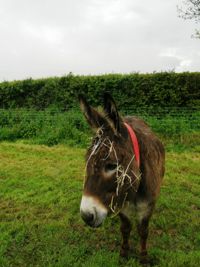Food Breakdown - Donkey
Physical breakdown

Before digestion can start, donkeys must first physically break down their food by the action of chewing. Every kilogram of hay that the donkey consumes needs to be chewed more than 2,000 times in order to reduce the forage to fragments of approximately 1.6 mm in length. These small fragments are much more readily digested than larger particles and allow the donkey to make efficient use of its food. Concentrated feeds require less chews per kilogram (1,000-1,500), whilst poorer quality feeds like straw require more chews per kilogram (2,500+).
The condition of the teeth has a large effect on chewing efficiency: donkeys with large molar protrusions and sharp hooks on their teeth will spend longer chewing and chew less efficiently than donkeys with flat molar tables. Keepers should keep a careful eye on the condition of their donkeys’ teeth, especially in donkeys more than five years old that have all their permanent teeth. The ejection of partly chewed food from the mouth (quidding) and the presence of long fibres or whole grains in the faeces are signs of advanced dental problems.
Donkeys should have their teeth rasped at least once a year by a qualified equine dentist, and the frequency of rasping will need to increase as the donkey gets older. Checking the donkey’s mouth should be an essential part of any routine veterinary examination carried out on working donkeys brought to mobile clinics. A few minutes spent rasping the teeth of a working donkey can make an immeasurable long-term improvement to its tough life. Checking and recording the condition of donkeys’ teeth at the time of purchase or adoption is also advisable because it provides a baseline observation with which future examinations can be compared.
Chemical breakdown
In donkeys, there are two distinct processes of chemical breakdown of food. These are referred to as ‘digestion’ and ‘fermentation’ but may also be referred to as ‘degradation’. Digestion is a process where enzymes produced by animal tissues break down food. Fermentation is a process where enzymes produced by bacteria, protozoa and fungi break down food, and the animal uses the end-products of these reactions as a source of nutrients. The animal provides the microbes with a favourable place to live and plenty of food. The microbes provide the animal with the energy-rich end-products of the break down of fibre, which would otherwise be unavailable. There is, therefore, a symbiotic relationship between the host and the micro-organisms.
The nature of donkeys’ food
The plant cells that make up most of the food that donkeys eat consist of two main fractions: cell contents and cell-wall material or fibre. Plant cell contents are highly digestible and very nutritious, but diminish rapidly in quantity as plants mature. The fibre component consists mainly of three different carbohydrates: hemicellulose, cellulose and lignin. When young, the plant cell wall is made up mainly of easily digestible hemicellulose (digestible fibre), but with age the amount of cellulose and lignin (indigestible fibre) in the cell wall increases. Consequently the fibre component becomes less digestible as the plant ages.
Cellulose is broken down by microbes in the large intestine of the donkey by the process of fermentation. Without these microbes, donkeys would not be able to make use of fibrous foods like straw and hay. Lignin is a woody substance that is virtually undegradable even by gut microbes.
Spring pasture is rich in plant cell contents and low in fibre, and is therefore very nutritious, but as the summer progresses the amount of fibre increases and the cell contents diminish, particularly when the grasses come into flower. The conserved forages (hay, haylage and straw) that are fed to donkeys are generally quite mature when harvested and have a relatively small amount of cell contents compared to the levels of fibre.
References
- Smith, D. and Wood, S. (2008) Donkey nutrition In Svendsen, E.D., Duncan, J. and Hadrill, D. (2008) The Professional Handbook of the Donkey, 4th edition, Whittet Books, Chapter 1
|
|
This section was sponsored and content provided by THE DONKEY SANCTUARY |
|---|